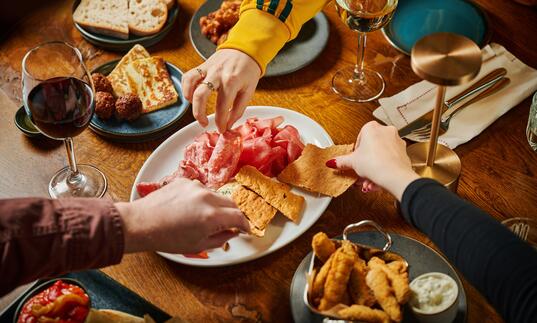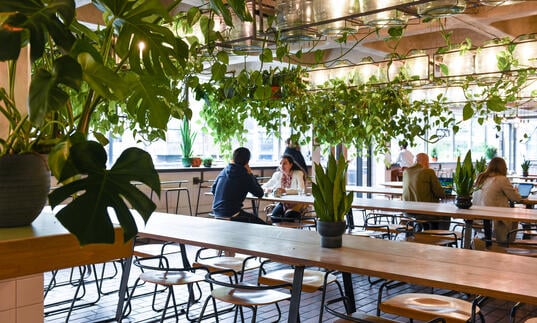Time For One More? Celebrating John Cumming - Digital Programme

Kevin Le Gendre spoke to John Cumming’s widow, Ginnie Smith, about his living legacy on jazz and the generations of musicians who, in his absence, continue to redefine it.
Tonight’s concert is not so much a tribute as a celebration and continuation of the work of somebody very significant. John Cumming was a co-founder of Serious, the company that produces a wide range of live music events, the most well-known of which is the annual London Jazz Festival. From the late 60s John was an irrepressible champion of all things creative, and the contribution he made to audience and artistic development was immeasurable. His passing in May 2020 greatly saddened those of us who knew him well. But, perhaps most importantly of all, it was also relevant to those who did not. Whoever sat in the stalls of a concert he programmed lent a vital energy and meaning to the music along with those who were stood on stage making it. The experience had to be good for everybody. Every performance had to resonate.
Few things excited John more than the arrival of new talent that would steadily grow over the years. Then again, his own career was built on graft and determination. Born in Edinburgh to parents in the medical profession, John studied English at the city’s university but became drawn to the world of theatre, working as a stagehand and lighting technician, thus gaining a thorough understanding of the nuts and bolts of the demanding process of production. Thereafter, his visits to London to see iconic soloists such as Sonny Rollins increased his interest in jazz, and he later managed tours by other U.S legends such as Carla Bley and George Russell. But it was his ability to create festivals that marked him out. John launched the Bracknell Jazz Festival and Camden Jazz Week in the 80s, and the London Jazz Festival in the early 90s. As John’s widow Ginnie Smith recalls, his roots in live music programming ran deep. ‘He started at the age of 16 by putting on jam sessions in the bar of the Traverse theatre in Edinburgh in 1965, after his mother first took him there. His theatre work really equipped him to do things well, to put on festivals and outdoor music events.’
‘An enduring memory I have of John is of him lighting a show outside, during a thunderstorm. But putting on Sonny Rollins and getting Chet Baker out of retirement were important to him. Then, shows at the Roundhouse in Camden led to the Camden Jazz Week and there was an emergence of young British artists around that,’ she recalls.
Drawing up a list of bands to pay tribute to John was possibly the easiest and hardest thing to do for his colleagues, currently and formerly at Serious. Dozens of artists owe him a debt of gratitude for the crucial opportunities he gave them, yet there are simply too many significant musicians he worked with over the years to mention. Nonetheless, the line-up for tonight’s concert is an excellent cross-section of the wealth of talent with which John was associated. It ranges from the revered elder statesmen of British jazz, Evan Parker and John Surman to the great shapeshifter Orphy Robinson, and the European artists who have become a key part of the London Jazz Festival, such as Nik Bärtsch. As for Andy Sheppard, Guy Barker, Joanna MacGregor, Nikki Yeoh and Spring Heel Jack, who play anything from jazz and classical to avant-garde electronica and dance music, they embody the eclecticism that was such an integral part of John’s vision. Newer generations of players, such as Dave Okumu, Alexander Hawkins, Maciej Obara, Elina Duni, Yazz Ahmed and Ayanna Witter-Johnson, remind us of how consistent John was at talent spotting. Last but not least, no band represents the idea of continuity and the future of music more than Gary Crosby’s Tomorrow’s Warriors, the workshop-education programme that has nurtured countless key figures in British jazz since the mid-90s, and with whom John had a fruitful, longstanding relationship.
John never forgot what it was like to be a listener as well as a producer and programmer. The sense of music as a shared, collective experience, a cherished moment that would bring people together, was a primary motivation for his work - which could run from relaxed informal gigs at small venues, to orchestral concerts on the biggest stages imaginable. He always wanted to ensure that the highest possible production values were maintained. That was part of the buzz. In the two decades in which I was privileged to know him I never saw him lose that crackle of energy following a great show. He did not seem to ever dim his passion for music.
Lest we forget, it took tremendous drive and resourcefulness for John Cumming to achieve what he did in his lifetime. He provided a platform for artists from around the world to bring beauty and dignity to one of the greatest genres of modern music. ‘His legacy is really getting jazz back into the concert hall,’ says Ginnie. ‘He put London back on the touring circuit, was a founder member of the Europe Jazz Network (EJN) and supported many young musicians. He ensured jazz was not banished to the backrooms of pubs. From his theatre background he simply knew about practicalities, about getting things done, he was a great believer in teamwork.’
Details
Performers
Jumoké Fashola compere
Kevin Le Gendre compere
Jez Nelson compere
Seb Rochford
Fraser Fifield
Kuljit Bhamra
Gwilym Simcock
Elina Duni & Rob Luft
John Parricelli
ESKA
Pete Wareham
Matthew Bourne
Ayanna Witter-Johnson
Andy Sheppard
Nik Bärtsch
Guy Barker
John Surman
Joanna MacGregor
Evan Parker & Spring Heel Jack (Matt Wright, Adam Linsom, John Coxon, Ashley Wales)
Yazz Ahmed
Black Top (Orphy Robinson, Pat Thomas & Shabaka Hutchings)
Alice Zawadzki
Alexander Hawkins
Maciej Obara
Nikki Yeoh
Dave Okumu
Jason Yarde
Tom Bancroft
Phil Bancroft
Cherise
Graeme Blevins
Chris Hill
Ralph Salmins
Gary Crosby’s Tomorrow’s Warriors
Eddie Hicks
Alex Ho
Aleksandra Topczewska
David Kayode
Michael Amosu
Nathan Dawkins
Emily Tran
Shanise Hall
Christ-Stephane Boizi
Plus, Jerry Dammers DJ set
Produced by Barbican in association with Arts & Parts.
With thanks to Yeast Culture for providing the video edits.
Hall
Location
The Barbican Hall is located within the main Barbican building. Head to Level G and follow the signs to find your seating level.
Address
Barbican Centre
Silk Street, London
EC2Y 8DS
Public transport
The Barbican is widely accessible by bus, tube, train and by foot or bicycle. Plan your journey and find more route information in ‘Your Visit’ or book your car parking space in advance.
We’ve plenty of places for you to relax and replenish, from coffee and cake to wood-fired pizzas and full pre-theatre menus
Mobility
Spaces for wheelchair users in row U at the rear of the stalls (up to sixteen, depth of row 180cm) and the back row of the circle (four), both with fold-down companion seats. Some seats in row S of the stalls for people with very limited mobility.
Assistance dogs
Assistance dogs may be taken into the concert hall where there are a limited number of suitable seats in row G of the stalls. If you prefer, you may leave your dog with a member of the cloakroom staff during the performance.
Hearing facility
There is an induction loop in the concert hall. You can use this by adjusting your hearing aid to the ‘T’ setting.
Free large-print programmes
These are available for most of our concerts. Please contact [email protected] at least a week beforehand, to prebook a large-print programmme.
For more access information, please visit our Accessibility section.





